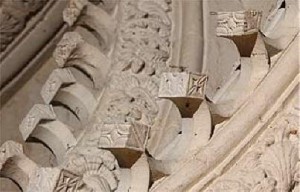Musical Cubes?

Japanese bid to solve mystery of the Rosslyn cubes
CLAIRE GARDNER
THE mystical symbols carved into the stone ceiling of Rosslyn Chapel have mystified historians for generations.
The 213 cubes are believed to be part of a musical notation system that recorded a melody of great spiritual significance to those who built it.
Now a Japanese electronics manufacturer is helping to fund research into decoding the symbols, in the belief that it could lead to the development of a range of muscle-relaxing products using vibrations from sound.
Eight scientists and music specialists from around the world are trying to understand the relationship between the symbols, which to the untrained eye look like a series of uninspiring lines and dots, and musical notes.
One of the theories is that the notes were recorded using a brass plate covered with sand. When the brass plate was struck with a bow, it vibrated, creating a distinctive pattern of sand lines for that particular note.
Stonemasons then took the patterns and carved them into the stonework to record the music played at religious ceremonies in the building.
Rosslyn Chapel, in Midlothian, was founded by the Knights Templar in 1477. It holds a special place in the hearts of new agers and mystics.
Among other things it is claimed to be the home of the Ark of the Covenant, the real Stone of Destiny, the heart of Robert Bruce, and even the head of Jesus Christ. But those behind the move to decode the notes on the chapel’s ceiling insist that their investigation is based on more than legend and wild speculation.
Jim Naples, the Scots-born managing director of Matsushita Electric Works UK, part of the international company which owns Panasonic, said his industry potentially had a lot to learn from the research.
His company makes machines which use vibrations to heal muscles, and he believes the combination of vibrations given off by the notes recorded at Rosslyn Chapel could help develop more effective machines.
“If you imagine your body,” he said, “we all consist of cells and vibrations. If you have healthy muscles then they vibrate at a certain frequency – if they are not healthy it would be a different frequency.
“What we try to do with some of our products is get the muscles back into a healthy frequency by pulsing them with ‘proper’ waves.
“If in Rosslyn the sacred notes could be decoded – and the music sung – we could record the frequency of the wavelengths produced by the music and re-create that frequency in a new ‘healing’ product.”
He added: “There are a lot of sceptics out there who might think this sounds quite crazy but it’s definitely something worth exploring. The electronics industry has a lot to learn from history.”
Music experts not connected to the project believe there is a high chance the symbols are in fact notes.
Warwick Edwards, of Glasgow University’s music department, specialises in medieval and renaissance music. He says the lines of the cubes may represent a 15th century way of recording music.
“There were all sorts of notation methods for all sorts of music,” he said. “For example, sacred music was noted using lines with a couple of blobs etched in the brickwork of a building.”
He added: “Rosslyn is such a unique place that there might well be some more surprises there.”
Author and historian Stephen Prior, who has been researching the history of Rosslyn, believes the cubes could hold the key to a health-giving chant from the Middle Ages.
He said: “We are convinced that when these are deciphered they will tell us something very interesting.”
But Neil Spurway, a former professor of exercise, physiology and muscle function at Glasgow University, said: “Even if they did crack the code I would doubt whether they would get a musical pitch to heal a body.”
“The only comparison would be ultra-sound, which helps break down scar tissue… the chance of any therapeutic effects done on an audible sound range would be tiny.”
© The Scotsman Publications Ltd
Scotland on Sunday.
16th June 2002.